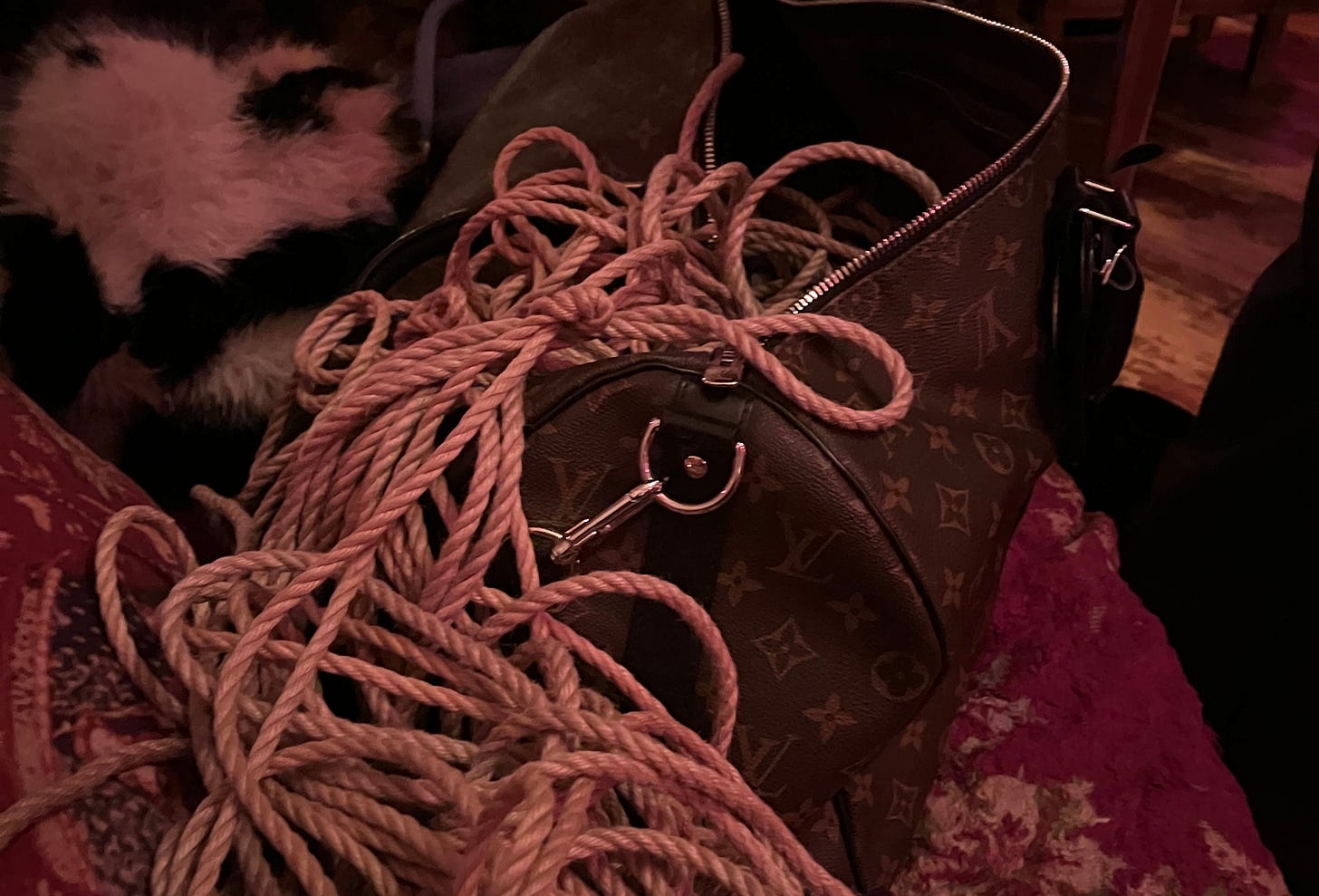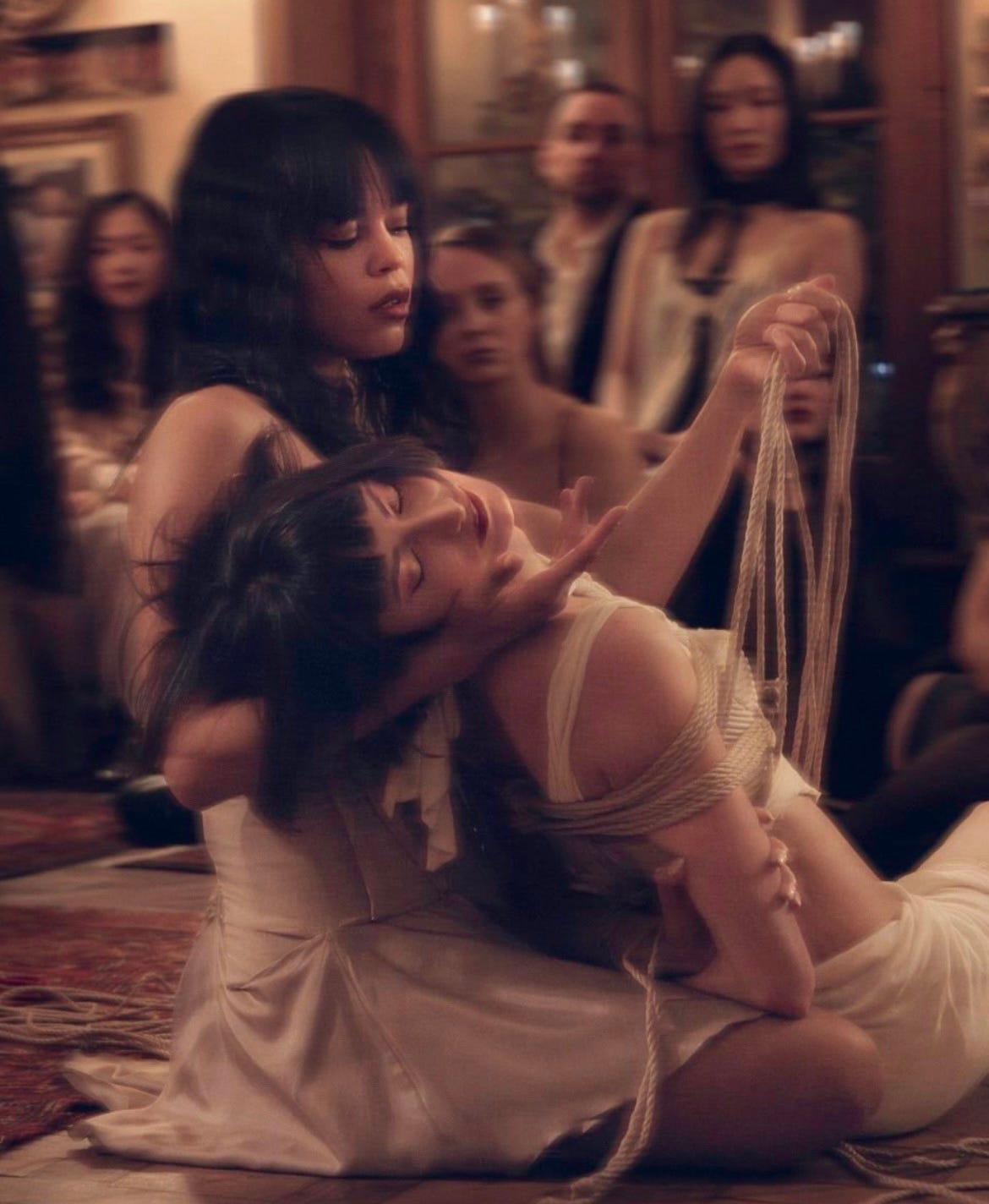Shibari at the Chelsea Hotel
Camille chronicles her first time being suspended in rope—and interviews experts on the art of surrender
In the spirit of gonzo journalism, I wrote about getting tied up by bondage experts—so if you’re related to me, I’d suggest you stop reading here. Everyone else: Have fun, be safe, and don’t try this at home!
The first time I dabbled in Shibari-style bondage, I lost sensation in my left thumb for months. This is, for practitioners of the craft, a known risk: one wrong move by the rigger, and you can sustain permanent nerve damage. That’s why Shibari isn’t just about rope; it’s about trust, technique, and a deep understanding of the body. And for Marie Sauvage and Hajime Kinoko—two of the world’s most sought-after riggers—it’s also about pushing rope bondage beyond the bedroom and into high art.
They’re performing at a mansion in lower Manhattan, and as spacious as it is, the place is packed with voyeurs. A hush falls over the crowd as Sauvage—one of the first women to publicly perform Shibari—emerges in a kimono and Tabi slippers, ready to inhabit the opposite role for an evening. Kinoko, her former mentor, binds and suspends Sauvage from the steel rig in the ceiling, using a complex and ever-evolving series of ties to twist her body into a series of exaggerated silhouettes, the intensity progressing in step with the music’s tempo.
Sauvage makes it look easy, but suspension isn’t for the faint of heart—which I learn firsthand a few weeks later, experiencing suspension for the first time under her watchful eye. Walking into the Chelsea Hotel, I find Sauvage lounging in the lobby, looking impossibly chic in a fur hat (she is French, after all.) We scale the stairs to my friend’s historic apartment, where she pulls seemingly endless coils of jute rope from her Louis Vuitton bag like kinky Mary Poppins. Then she gets to work, guiding my partner and I through the process like it’s just another Tuesday. Which, for her, it is.
An hour or so later, I’m gently swinging from the steel ceiling rig, the rope guiding me in slow circles like the string of a marionette. The feeling is, to my surprise, almost exactly what I imagined: an experience of acute embodiment, the intensity of which is emphasized by the sharp bite of jute around my limbs and the inevitable feeling of surrender.
Being suspended in rope is, above all, an exercise in trust: “When you’re tied, either you panic, or you let go,” Sauvage says. “In the beginning, you think, This is scary, I’m out of control—but when you trust your rigger and realize you’re afraid for no reason, there’s an endorphin rush and your muscles relax. By the end, it’s like you’re floating on a cloud.”
During a suspension session, Kinoko and Sauvage are attuned to dozens of tiny details: from the model’s movements to the temperature of their skin, which can indicate their body’s limits even before they’re aware of them. I experienced this myself when—after hanging upside down for several minutes at the Chelsea—Sauvage detected a spike in my body temperature and swiftly untied the ropes just before I began to experience a faint ringing in my ears. It’s a common physical response for first-timers—and after a few minutes horizontal, I was back in the saddle, having also experienced the potent cocktail of endorphins that keeps people coming back again and again.
“In the beginning, you think, This is scary, I’m out of control. By the end, it’s like you’re floating on a cloud.”
The word Shibari—meaning “binding” or “tying”—came into common use in the West in the ’90s to describe Japanese-style bondage, also known as Kinbaku. Though now used to describe a practice that focuses on the aesthetics and display of the body, many of the rope patterns associated with Shibari derive from hojōjutsu, a tying technique originally used in the Edo period to arrest, restrain, and torture prisoners of war. Though these ties have since been modified for greater comfort and safety, rope bondage is often still associated with elements of BDSM, namely erotic humiliation and dom/sub dynamics.
Artists like Sauvage bring a different tenor to the practice: “There is a subcategory of Shibari that is about sadism, really pushing the limits of the body. But I think what a lot of people want is to learn how to be vulnerable,” she says. “I see Shibari going in a direction that is more artistic, a bit more spiritual.”
Kinoko agrees. When he first started performing, Shibari was associated primarily with kinksters—but now, it’s been featured in art museums and fashion editorials, pushing the practice into the mainstream. He got his start tying at the request of his then-girlfriend; then, he channeled his chiropractic training toward the development of new tying techniques, including his signature web-style rope installations.
Sauvage, for her part, was drawn to rope as an act of rebellion. “My whole life, I was always just slightly sexually obsessed. And I felt it wasn’t fair that women were not allowed to embody this natural impulse,” she says. But it wasn’t til she witnessed the burlesque legend Dita Von Teese perform that she realized she, too, wanted to be onstage. “I didn’t feel like burlesque was my thing, and I love Shibari because it’s about trust. It’s about connecting with other people. It’s a really meaningful life to inspire people, especially in a world that’s so sex-negative.”
As Shibari’s visibility grows, so does the threat of censorship. Social media platforms frequently flag their work as “sensitive,” but Sauvage and Kinoko are determined to keep rope bondage in the public eye. The response speaks for itself: At a recent performance, 700 people crammed into a venue to watch the pair at work. “We needed a big screen so everyone could see, like a concert,” Kinoko says.
“There is a subcategory of Shibari that is about sadism, really pushing the limits of the body. But I think what a lot of people want is to learn how to be vulnerable.”
Witnessing the world’s response to these performances, it’s clear that the desire to be bound—to let go completely—is universal. And whether for sexual gratification or emotional catharsis, rope can be a powerful tool of self-discovery. This is what keeps Sauvage and Kinoko practicing, year after year: “I was inspired to adopt an art practice that has to do with the body that makes people feel so empowered and liberated, even healed,” Sauvage says. “It’s not just sexy and beautiful. It’s also really meaningful for people.”
This is true, too, when Shibari is applied toward kink. The boundary between pain and pleasure is, for many, as thin as the rope that binds them—and in their performances and workshops, Sauvage and Kinoko create a safe space for first-timers to surrender their defenses.
Often, the experience unlocks something inside of them, Sauvage says; the intense physical sensation of being bound, coupled with the heightened emotional vulnerability that comes with it, can make some people feel drunk afterward, or push them toward emotional breakthroughs.
“Their reactions can be so visceral and moving. Sometimes, people will cry, because there’s this sense of catharsis. At one event I did a week ago, a woman came up to me and said, You changed my life,” Sauvage recounts. “At the end of the day, everyone wants to connect and be vulnerable—and the way we do Shibari, it’s about learning to trust.”
You can follow Marie Suavage (marie.sauvage) and Hajime Kinoko (@hajime_shibari) on Instagram for more photos + tour updates. If you’ve ever experimented with Shibari, I’d love to hear about your experience, so sound off in the comments!






I’m sooo jealous. I dream of being tied by her 🖤 the artistry and aesthetic involved is so beautiful